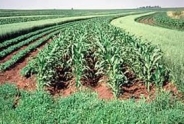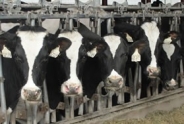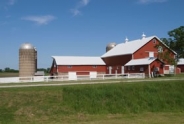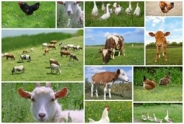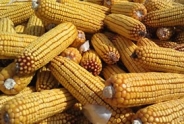Dry Manure Spreader Calibration
Amy Barkley, Livestock Specialist
Southwest New York Dairy, Livestock and Field Crops Program
Spring is progressing! The weather is getting warmer, the ground is drying out, and it's getting to be around that time to clean out barns and manure storages.
Manure is an excellent source of nutrients and organic matter for pastures, hayfields, and cropland. A proper application rate of manure ensures that it's spread evenly in a way that matches nutrient management recommendations and crop needs.
There are several variables that affect application rates. These include the speed of the tractor going over the ground at the time the manure is spread, the gearbox settings, and the PTO speed. The apron or hydraulic push gate setting and spreader gate opening settings will also impact the rate of unloading. Not all of these items will be found on every tractor/spreader set-up, so it's a good idea to know which ones will affect you.
There are two main ways of calibrating a solid manure spreader:
Load Area Method:
This method involves weighing your spreader before and after the application of one load to find the weight of manure it carries, and then determining the area that manure is spread over. Drive-on scales and a distance measuring device are required for this method.
Each axle of the full spreader should be weighed as well as the tongue. After the manure is spread, the spreader will need to be weighted again to determine an empty weight. Subtracting the empty weight from the full weight will give you the weight of manure the spreader carries.
Once you have the weight of the manure determined, you can then measure the length and width of the area that the manure was spread over to find the area of coverage (in square feet).
Once these two numbers are determined, use the equation below to solve for tons of manure spread per acre:

The conversion factor, 21.8, comes from dividing the square feet in an acre (43,560 sqft) by 2,000 pounds per ton.
Tarp Method:
This method doesn't require drive-on scales, but still requires a distance measuring device. It also requires a pre-measured tarp (in sqft), heavy objects for weighing down the corners of the tarp, a container in which to put the collected manure and tarp, and a scale. To perform this evaluation, first take the weight of the tarp and container before any manure is applied. Then, load the spreader and lay down a tarp in the center of the spreader's track, about 25' - 50' from where you will start spreading.
When accounting for overlap during passes, make sure the tarp is placed in the center track of where at least three passes will occur.
Once the manure has been spread, pick up the tarp, taking care to keep all the manure on it by folding the corners into the center. This tarp and manure can then be placed in the container and weighed. The initial weight of the empty tarp and container will be subtracted from the filled tarp and container weight to find the pounds of manure spread on the tarp.
Then, using the same equation as the Load Area Method, you can calculate the tons of manure spread/acre.
Regardless of the method used, the calibration should be repeated three times to come up with an average rate. This will help account for variables in loading and manure consistency, especially if the manure is taken from different areas of a storage.
Because of the variables impacting application rates, it is a good idea to write down the exact settings you are using to achieve the spread rate you're looking for. This will make it easier to spread the calibrated amount time after time. If there is a change to your equipment, bedding and manure management, or if the type and/or consistency of the manure changes quite a bit, re-calibrating is recommended. That said, it's still a good idea to recalibrate every couple of years.
For a video demonstration on solid manure spreader calibration, you can check out this video from the University of Minnesota Extension Manure Management Team: https://www.youtube.com/watch?v=l0JHLO80B4E
Upcoming Events
WNY Pastureland Conversion & Soil Health Field Day
July 16, 2025
Middleport, NY
Join American Farmland Trust for the Western New York Soil Health Field Day on July 16, 2025, at Zeliff Farm in Middleport, NY, from 9:00 AM-3:15 PM. Learn about pasture conversion, soil health benchmarking, biochar in grazing systems, and best grazing practices. Plus, enjoy hands-on demos with the NY Soil Health Trailer, drones, and cover crops! Check out the attached agenda for more information about the field day and REGISTER HERE. Zeliff Farms is a regenerative beef operation who has recently partnered with AFT on outreach and education to farmers including learning circles and evaluating biochar effects on soil health.
IPM Strategies to Protect Corn and Soybean Seed in NY
July 30, 2025
Hamburg , NY
SWNYDLFC and Cornell IPM are hosting a grower meeting to discuss integrated pest management strategies for protecting corn and soybean seed in New York.
FAMACHA Training for Sheep and Goat producers in Woodhull NY
August 13, 2025 : FAMACHA Training in Woodhull
Woodhull, NY
Join us for a discussion and hands-on training for internal parasite integrated pest management in sheep and goats. Certification is available to all students participating in the workshop.
Announcements
No announcements at this time.

